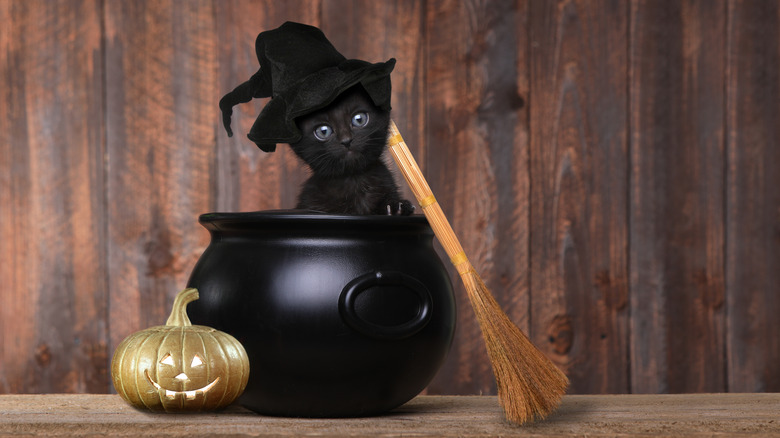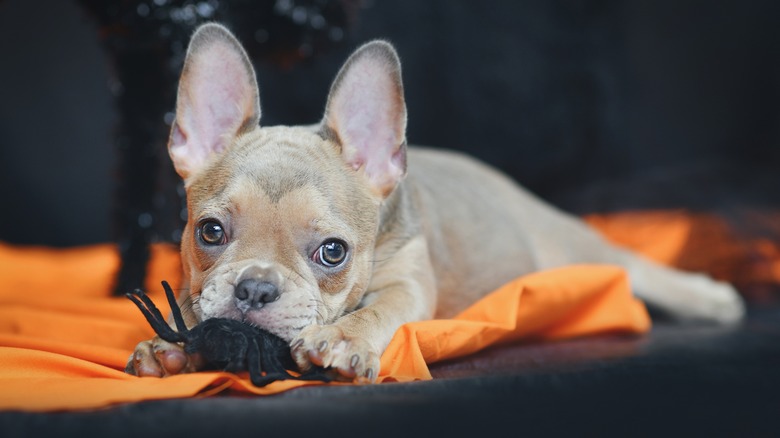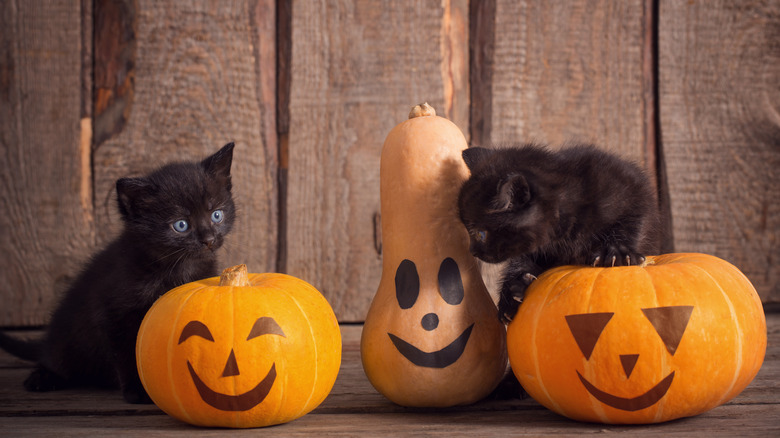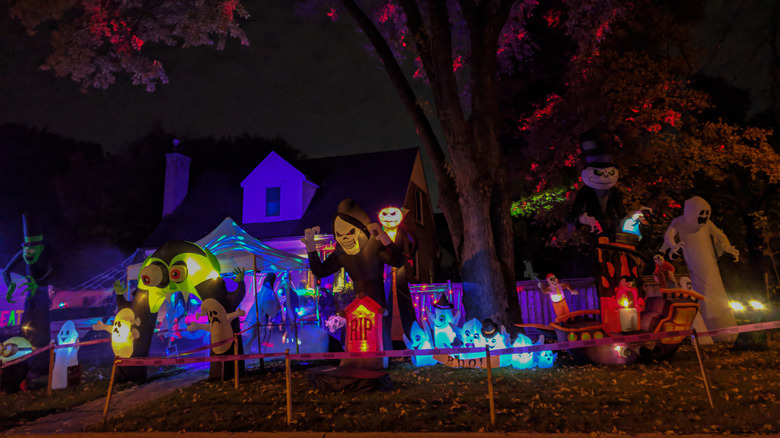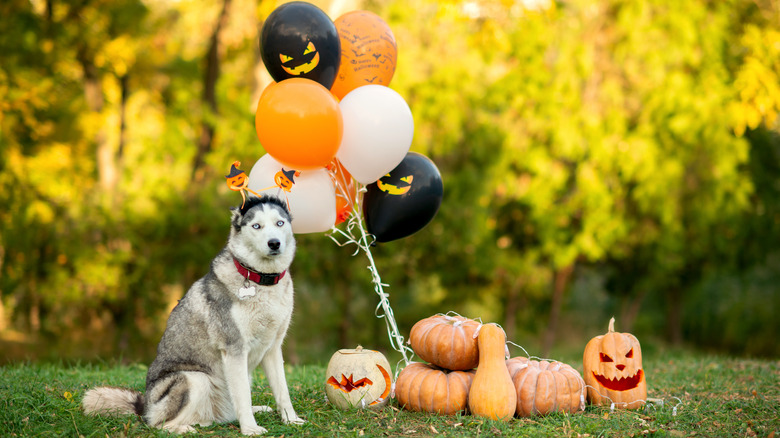How To Choose Halloween Decorations In A Pet-Friendly Way
Halloween is one of our favorite times of the year, and we're all on board with turning the season into a six-week-long extravaganza to rival the winter holidays that kick off on November 1. While Halloween is a spooky good time for humans, it can pose some real perils for our pets. Halloween night itself can be second only to the 4th of July in provoking pet anxiety, since the constant ringing of the doorbell, and coming and going of absolute strangers may result in cats camping out in closets and dogs going into full freak-out mode as they attempt to defend their territory against this unprecedented (since last year anyway) invasion.
Even if you've got your pets' safe space all prepared in advance of Fright Night, however, you should still take some care as you decorate your home for the holiday. Even the cutest, least-frightening Halloween decorations may pose hidden dangers for doggos and kitties.
Keep decorations out of your pet's paws (or mouth)
Sure, it's fun to adorn your house with all manner of witches, ghosts, goblins, and other types of Halloween-y ornamentation, but as Brookhurst Animal Medical Center points out, your puppers are likely to see any new additions to your décor as potential chew toys. This is not good, since Embrace Pet Insurance notes that these may be made with harmful chemicals. Cats are more likely to want to knock them off your shelves and counters, which is better, but still not something you probably want going on, particularly if you have both types of pets — since the dogs will wind up gnawing on whatever the cats knock over.
Be sure to put all decorations out of reach, especially any that have hanging or dangly bits, as these are often irresistible to cats who want to take a swat or dogs who just want to give them a good yank. If you have very tall pets, or ones who can jump, you may want to have some additional protection by squirting your decorations with ammonia, vinegar, or a product specifically meant as a pet repellent. If you're planning to plug in any indoor lights, make sure that the plugs and wires are out of reach or blocked off behind a pet-proof barricade of sorts, and definitely string the lights up high enough that these are out of your pets' reach, as well.
Pet-proof your pumpkins
Planning to carve a few jack-o'-lanterns for Halloween? Well, the good news with pumpkins is that they are not on the list of dangerous foods for pets to eat. In fact, Rover reports that canned pumpkin can be a good source of fiber for both dogs and cats. Jack-o'-lanterns, however, can develop some nasty bacteria after they've been carved and allowed to sit and rot awhile, so you don't want your pet to start chewing on any well-aged ones.
Brookhurst Animal Medical Center says that pumpkin seeds aren't the best for pets, though, so keep the pumpkin guts away from your animals as you prepare to carve the jack-o'-lanterns. Also, be careful with the knife, particularly if you have a pet who always wants to lend a helping paw with whatever you're doing. As a final note on the subject of jack-o'-lanterns, consider using LED lights rather than candles to illuminate them so that no inquisitive noses or whiskers get burned.
Save the electronics and inflatables for your porch
If you've ever been walking through a Walgreen's or CVS in early October, there's a chance you may have been startled to hear sudden shrieking, cackling, or an eerie voice singing something about worms crawling in and worms crawling out. After a moment, you collect yourself and remember "oh yeah, Halloween is coming," and realize you just walked past a motion-operated electronic decoration. Your pets, however, are unable to make this leap of logic, so New York Family points out that they are more likely to react to any type of moving and/or noise-producing decoration with a flight-or-fight response.
If you don't want a cat who won't come out from under the bed for a week, a puppy who pees on the carpet out of fright, or a big dog who takes out your expensive new toy with a few well-placed bites, it's best to leave any such decorations on the porch or in the yard. This goes for inflatables, as well. While non-animated ones may not be so frightening to pets, curious paws, claws, and teeth may lessen the chance that they'll last through the Halloween season.
Be mindful of outdoor animals
Whether it's a cat that likes to go for outdoor excursions, a dog on an off-leash jaunt, or wandering wildlife such as squirrels, foxes, and deer, animals out-of-doors are also in danger from certain types of Halloween decorations. In Defense of Animals notes that extension cords should be secured so that they don't entrap, electrocute, or strangle any animals, and dangling lights should also be avoided for this reason. Fake spider webs can entrap birds, snakes, or small rodents –- even if you're not terribly sympathetic to the latter two species, just remember that you're going to have to be the one to disentangle them! You should also avoid leaving pumpkins out on the porch for too long after Halloween is over, since unwanted visitors might drop by to nibble at this rotting vegetation buffet.
If you're not going to be home on Halloween night, you might think it would be a nice thing to do to leave a self-serve bowl of candy on your porch, but you should probably reconsider this. Even if the first trick-or-treater doesn't grab it all, the stuff in the bowl will be an attractive nuisance (or rather, a hazard) for any animals that happen along. Not only are chocolate and xylitol very bad for animals, as per Embrace Pet Insurance, but pets and wild animals can also choke on the wrappers.
